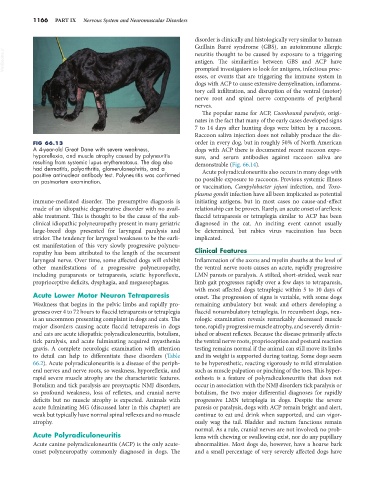Page 1194 - Small Animal Internal Medicine, 6th Edition
P. 1194
1166 PART IX Nervous System and Neuromuscular Disorders
disorder is clinically and histologically very similar to human
Guillain Barré syndrome (GBS), an autoimmune allergic
VetBooks.ir neuritis thought to be caused by exposure to a triggering
antigen. The similarities between GBS and ACP have
prompted investigators to look for antigens, infectious proc-
esses, or events that are triggering the immune system in
dogs with ACP to cause extensive demyelination, inflamma-
tory cell infiltration, and disruption of the ventral (motor)
nerve root and spinal nerve components of peripheral
nerves.
The popular name for ACP, Coonhound paralysis, origi-
nates in the fact that many of the early cases developed signs
7 to 14 days after hunting dogs were bitten by a raccoon.
Raccoon saliva injection does not reliably produce the dis-
FIG 66.13 order in every dog, but in roughly 50% of North American
A 4-year-old Great Dane with severe weakness, dogs with ACP there is documented recent raccoon expo-
hyporeflexia, and muscle atrophy caused by polyneuritis sure, and serum antibodies against raccoon saliva are
resulting from systemic lupus erythematosus. The dog also demonstrable (Fig. 66.14).
had dermatitis, polyarthritis, glomerulonephritis, and a
positive antinuclear antibody test. Polyneuritis was confirmed Acute polyradiculoneuritis also occurs in many dogs with
on postmortem examination. no possible exposure to raccoons. Previous systemic illness
or vaccination, Campylobacter jejuni infection, and Toxo-
plasma gondii infection have all been implicated as potential
immune-mediated disorder. The presumptive diagnosis is initiating antigens, but in most cases no cause-and-effect
made of an idiopathic degenerative disorder with no avail- relationship can be proven. Rarely, an acute onset of areflexic
able treatment. This is thought to be the cause of the sub- flaccid tetraparesis or tetraplegia similar to ACP has been
clinical idiopathic polyneuropathy present in many geriatric diagnosed in the cat. An inciting event cannot usually
large-breed dogs presented for laryngeal paralysis and be determined, but rabies virus vaccination has been
stridor. The tendency for laryngeal weakness to be the earli- implicated.
est manifestation of this very slowly progressive polyneu-
ropathy has been attributed to the length of the recurrent Clinical Features
laryngeal nerve. Over time, some affected dogs will exhibit Inflammation of the axons and myelin sheaths at the level of
other manifestations of a progressive polyneuropathy, the ventral nerve roots causes an acute, rapidly progressive
including paraparesis or tetraparesis, sciatic hyporeflexia, LMN paresis or paralysis. A stilted, short-strided, weak rear
proprioceptive deficits, dysphagia, and megaesophagus. limb gait progresses rapidly over a few days to tetraparesis,
with most affected dogs tetraplegic within 5 to 10 days of
Acute Lower Motor Neuron Tetraparesis onset. The progression of signs is variable, with some dogs
Weakness that begins in the pelvic limbs and rapidly pro- remaining ambulatory but weak and others developing a
gresses over 4 to 72 hours to flaccid tetraparesis or tetraplegia flaccid nonambulatory tetraplegia. In recumbent dogs, neu-
is an uncommon presenting complaint in dogs and cats. The rologic examination reveals remarkably decreased muscle
major disorders causing acute flaccid tetraparesis in dogs tone, rapidly progressive muscle atrophy, and severely dimin-
and cats are acute idiopathic polyradiculoneuritis, botulism, ished or absent reflexes. Because the disease primarily affects
tick paralysis, and acute fulminating acquired myasthenia the ventral nerve roots, proprioception and postural reaction
gravis. A complete neurologic examination with attention testing remains normal if the animal can still move its limbs
to detail can help to differentiate these disorders (Table and its weight is supported during testing. Some dogs seem
66.2). Acute polyradiculoneuritis is a disease of the periph- to be hyperesthetic, reacting vigorously to mild stimulation
eral nerves and nerve roots, so weakness, hyporeflexia, and such as muscle palpation or pinching of the toes. This hyper-
rapid severe muscle atrophy are the characteristic features. esthesia is a feature of polyradiculoneuritis that does not
Botulism and tick paralysis are presynaptic NMJ disorders, occur in association with the NMJ disorders tick paralysis or
so profound weakness, loss of reflexes, and cranial nerve botulism, the two major differential diagnoses for rapidly
deficits but no muscle atrophy is expected. Animals with progressive LMN tetraplegia in dogs. Despite the severe
acute fulminating MG (discussed later in this chapter) are paresis or paralysis, dogs with ACP remain bright and alert,
weak but typically have normal spinal reflexes and no muscle continue to eat and drink when supported, and can vigor-
atrophy. ously wag the tail. Bladder and rectum functions remain
normal. As a rule, cranial nerves are not involved; no prob-
Acute Polyradiculoneuritis lems with chewing or swallowing exist, nor do any pupillary
Acute canine polyradiculoneuritis (ACP) is the only acute- abnormalities. Most dogs do, however, have a hoarse bark
onset polyneuropathy commonly diagnosed in dogs. The and a small percentage of very severely affected dogs have

